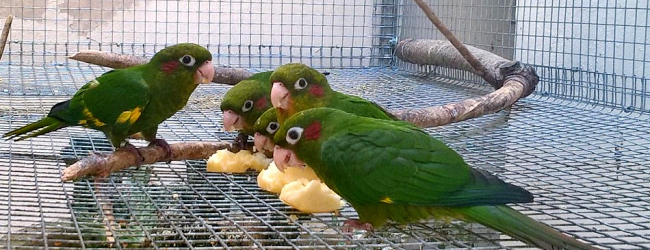
Read also the second part of this article:
.
The sulphur-winged conure or Hoffmann’s conure, known worldwide as Pyrrhura hoffmanni gaudens, is a subspecies of Pyrrhura hoffmanni species. It holds the nominal subspecies P. h. hoffmanni and P. h. gaudens, more common in European aviculture, which is different from the nominal one for its yellow (sulphur) painted wing feathers and for its yellow suffusions on the head. It is a beautiful medium sized conure, one of the biggest of genus Pyrrhura not very much spread yet in Europe, but with some breeders that breed it regularly. I started to find information about it some years ago when I saw some pictures on internet, then I remained actually fascinated by its beauty which reminded me those rare and charming south american parrots which are not bred in captivity.
I already found three or four years ago several specimens for sale in Germany and Netherlands but didn’t succeed to reach them that time because of the distance and my young age. One year later I was quite next to finally get them, when I saw two pairs offered for sale on internet. But unfortunately after four minutes the advertisement was online, the birds were already sold, and I arrived too late when I called the Dutch breeder by phone. I didn’t give up and some months later, at the of 2014, a good friend of mine finally helped me with two young pairs. When they arrived at my place in February 2015, I was just happy like a kid receiving a Christmas present.
.
.
I settled them in my indoor breeding room for a few months because of the cool weather of that period. In the meanwhile I built two flights 2x1x1 meters, with swinging bowls and a deep and tight nestbox made of 2cm thick wood. Environmental enrichment was made by green pine branches they could use for perches and destroyed after several weeks. The two pairs were put in the aviaries during the first warm weeks of spring in May in order to start the acclimatization slowly. The two aviaries were not divided with close panels at first, then after the summer, I decided to put some panels to close most of the side they could see from.
I didn’t close all the side because I noticed that both pairs when they were housed indoor copulated sometimes and copulated again when they were outside in aviaries. These copulations were seen by me as a consequence of territoriality of the two pairs once they could see each other, so I decided to close only half side of the aviaries (the half side near nestboxes) to avoid any type of disturb from a pair to the other near the nesting area.
.
.
I think fresh food is important for a breeder of south american parrots, even though it is known to be hard in Europe to provide exotic fresh food. So I just try to give to the pairs of P. hoffmanni gaudens differentiated types of foods in relationship to the seasonal availabilities. The standard diet I provide them is composed by parakeets seeds mix from Versele Laga, apple, different minerals sources and a mix of dried fruits which they put in water to rehydrate them. Other types of food are given occasionally like bananas, chicory, sprouted seeds, pomegranates, apricots. To be given occasionally do not mean they are not important in the diet, on the contrary it is a key of a good diet for me.
.
Title photo: Pietro de Paolis